Course Details

Dual Degree
APU-DMU Dual Degree Programme
Students who are under Bachelor’s Degree Programme will have the option to opt-in for the APU-DMU Dual Degree Scheme. Under this Scheme, students will receive 2 Degree Certificates & Transcripts upon graduation: 1 from Asia Pacific University (APU), Malaysia and 1 from De Montfort University (DMU), UK.
The Bachelor of Science (Honours) in Architecture is a Basic First Stage pre-professional qualification in the pathway leading to qualification as an Architect in Malaysia. The Council of Architectural Accreditation and Education Malaysia (CAAEM) or Majlis Akreditasi dan Pendidikan Senibina (MAPS) Malaysia is the body empowered by the Board of Architects Malaysia or Lembaga Arkitek Malaysia (LAM) to regulate and monitor architectural education and accreditation of Architecture programmes in Malaysia. The programme aims to provide exemption from LAM Part I Examination and is the Basic First Stage pre-professional architectural qualification as well as meeting the professional criteria. The programme develops transferable skills that support careers in other related fields and disciplines.
The APU Bachelor of Science (Honours) in Architecture is approved by Board of Architects Malaysia (LAM) and provisionally accredited by Malaysian Qualifications Agency (MQA).
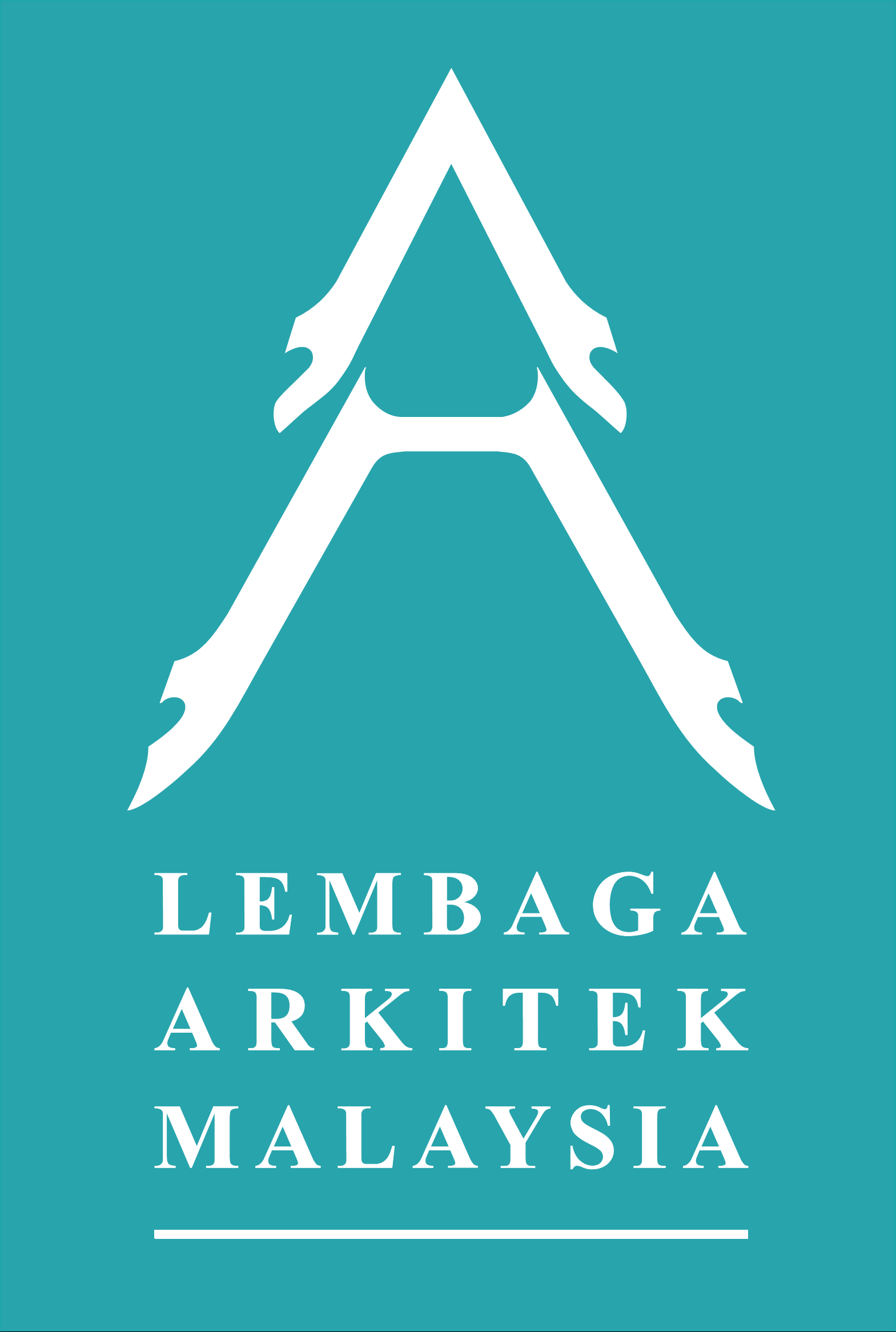
Journey
To become an Architect in Malaysia
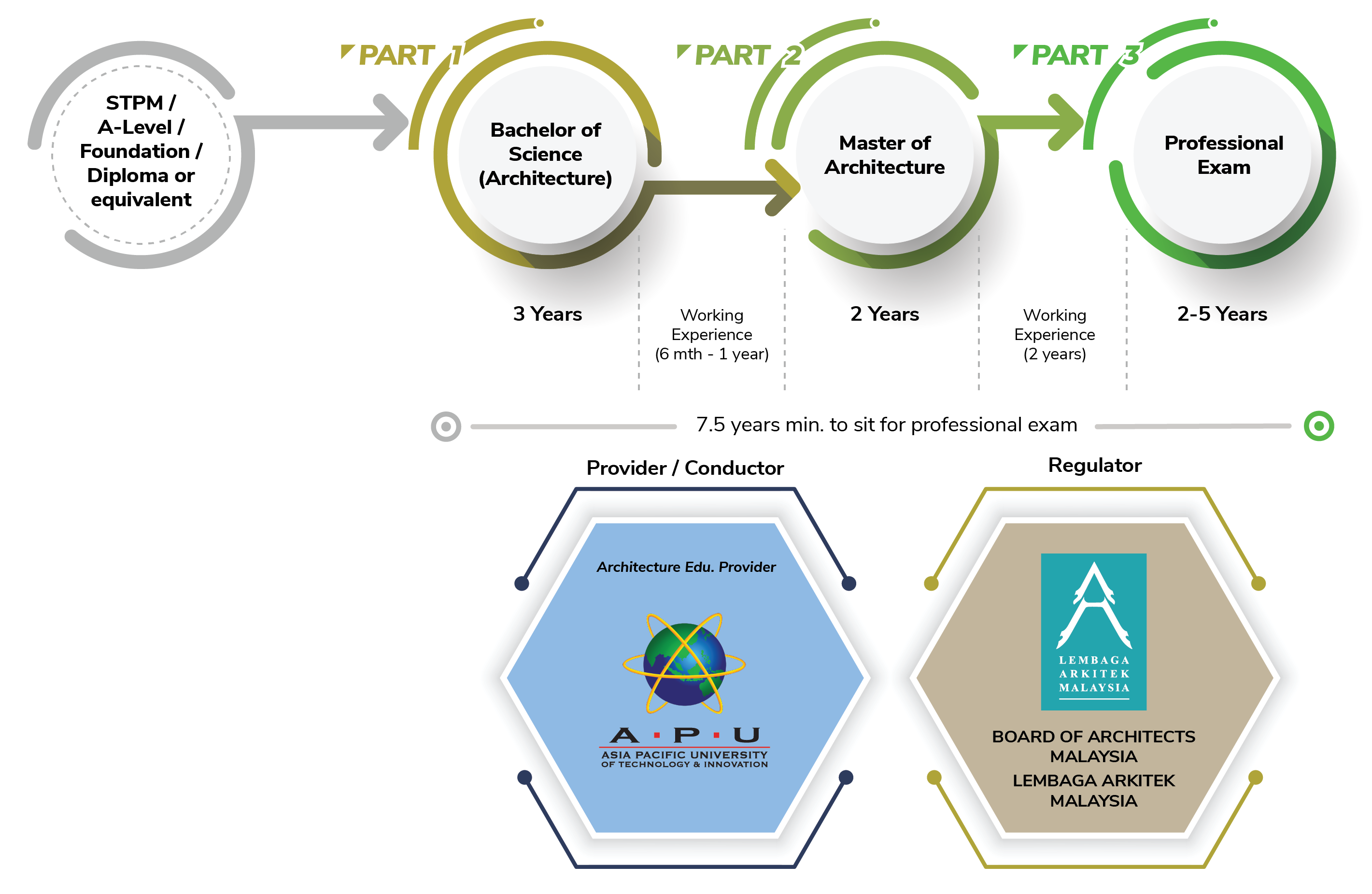
Requirements
Admission Requirements
- Minimum Grade C in 2 subjects and a Credit pass in SPM/O-Level Mathematics or equivalent
- Minimum Grade D in 2 subjects, excluding General Paper and a Credit pass in SPM/‘O’ Levels Mathematics
- Pass with Minimum 5Bs, including Credit in Mathematics
- Pass with minimum CGPA 2.00
- Pass with CGPA 2.00
- A Diploma in Architecture related areas with a minimum CGPA of 2.00 and fulfilment of requirements for Credit Transfer is subject to approval by the APU Academic Board.
Note: The above entry requirements may differ for specific programmes based on the latest programme standards published by Malaysian Qualifications Agency (MQA). The qualification and entry requirements for the programmes will be determined based on the "Comparison List of Equivalency of International Qualifications with SPM (O-Levels equivalent) and STPM (A-Levels equivalent)" published by Malaysian Qualifications Agency (MQA).
A Credit pass in Mathematics at SPM/O-Level or equivalent qualification can be waived should any other higher qualifications contain Mathematics with an equivalent/higher achievement.
Pass the Architecture Aptitude Test to be determined by the HEP as required.
Pass an Interview OR submission of Portfolio as required.
- IELTS : 5.0
- TOEFL IBT : 40
- Pearson (PTE) : 47
- MUET : Band 3.5
For more information please click HERE
What We Teach
This programme is specifically designed to provide students with:
- The Bachelor of Science (Honours) in Architecture aims to offer students an outstanding education of comprehensive knowledge of discipline areas; deep understanding of individual components, concepts, and theories; skills in applying methods within a discipline; and the competencies required to apply knowledge in studies and in practice.
- The programme is design-oriented and will help students develop the design and complementary skills expected in an innovative architecture programme. Students learn how to use resources, materials and computer technologies as well as acquire a good understanding of architectural history, construction technology and architectural practice to contribute to the improvement of the built environment.
- The Bachelor of Science (Honours) in Architecture is a multidisciplinary programme that aims to train students to be specialised in architectural knowledge and to possess a diverse set of transferable skills in visual and spatial literacy; ethics and practice; critical and cultural thinking; climate literacy and regenerative design; design for all, and progressive professionalism; for the development of sustainable designs towards ensuring a healthy environment for future generations.
- The programme aims to provide exemption from LAM Part I Examination and is the Basic First Stage pre-professional architectural qualification. As well as meeting the professional criteria, the programme develops transferable skills that support careers in other related fields and disciplines.
- The overall aim of the Bachelor of Science (Honours) in Architecture programme is to produce graduates with skills that will help in the development of the country and enable them to progress to their careers in Architecture.
-
Degree Level 1
Architectural Design Studio 1: Exploring and Experiencing Architecture
The aim of Architectural Design Studio 1 is to initiate exploratory thinking and creative capacities in beginning students through spatial explorations, particularly focused on the relationship between the body and interior space. Understanding of space, material, organisation, and composition are explored through topics of proportion, ergonomics, scale, and circulation, framed around specific methodologies of craftsmanship, tools, materials, and representation in both 2D and 3D.
Architectural Design Studio 2: Creating and Writing Architecture
Architectural Design Studio 2 will be a student’s first architectural proposal responding to both existing sites and specific users that encapsulates modern and current architectural history, theory and practice with a particular focus on architectural tectonics, theories of experience and time-based architectures. Students will evolve a design enquiry from idea to strategy to architectural proposal for a small sized modestly detailed design proposal that responds to people’s needs and use of place. Students will learn to interpret writings and buildings, to develop their reading and writing skills, and to make use of the fundamental conventions of academic writing.Semester 1
- Architectural Design Studio 1
- Architectural Representation
- Architectural History and Theory
Semester 2
- Architectural Design Studio 2
- Construction Technology
Elective
- Digital Architecture
-
Degree Level 2
Architectural Design Studio 3: Exploring and Practicing Ethical Design
The aim of this module is for students to design a medium sized moderately detailed architectural spatial and tectonic proposition in responce to contingencies and questions of ethical response, namely the needs and aspirations of building users and other stakeholders, accessibility, health and life safety and the relation to an urban context. This module will introduce urban design studies and the relationship between buildings and the surroundings for relevant and contemporary responses to an urban condition and local planning legislation. Students will be encouraged to develop ethical professional behaviours through participation with tutors, peers and other stakeholders in a collaborative studio practice mode to collectively produce work and taking an increasingly active role in framing their individual design work, in terms of approach, scope, brief, scale and media.
Architectural Design Studio 4: Exploring and Applying Climate Literacy
The aim of this module is for students to design a medium sized moderately detailed architectural spatial and tectonic proposition to show compliance with aspects of the Green Building Index (GBI) and the principles of landscape architecture. Students will demonstrate both an ability to outline strategies in responding to technical and environmental issues of landscape architecture and user requirements through the lens of a climate literacy toolkit, and to resolve their spatial proposal at a scale (1:50) to reveal how tectonic choices and structural techniques enhance and expand the architectural idea and respond to local climatic conditions.Semester 3
- Architectural Design Studio 3
- Integrated Technology
Elective
- Critical and Cultural Studies
Semester 4
- Architectural Design Studio 4
- Energy and Building
Elective
- Environment and Behaviour
-
Degree Level 3
Architectural Design Studio 5: Design Enquiry and Proposition
The aim of the Architectural Design Studio 5 (ADS5) is to teach students the strategies and principles of legislation surrounding fire safety, health and life safety, construction design and management and post-occupancy. Students will also be taught evaluation tools for predicting and monitoring building performance.
Architectural Design Studio 6: Design Synthesis and Resolution
Architectural Design Studio 6 (ADS6) builds on prior knowledge and abilities gained in Architectural Design Studios regarding design exploration, experience, creation, writing, ethics and climate literacies to integrate aspects of technical, environmental and professional practice decisions with the design process, synthesis and resolution to produce a large sized architectural spatial and tectonic proposition for a specific site. The ancillary aim of this module is for the students to develop a detailed design of a major element of their final design project, evidenced by a sectional drawing or model, to represent the integration of material choice and assembly, construction systems, environmental and structural considerations and the impact on and from human use. The module concludes at the Degree Exhibition, where students will apply professional behaviours and skills to collectively design, produce, brand and curate all Final Architectural Design Studio works.Semester 5
- Architectural Design Studio 5
Elective
- Contextualising Architectural Humanities
- Project Management and Innovation
Semester 6
- Architectural Design Studio 6
- Professional Practice
Elective
- Critical Building Analysis
- Architectural Design Studio 5
-
MQA Compulsory Subjects*
- Appreciation of Ethics and Civilisation (M’sian Students)
- Malay Communication Language (Int’l Students)
- Philosophy and Current Issues
- Workplace Professional Skills
- Integrity and Anti-corruption
- Co-Curriculum
(*All students are required to successfully complete these modules as stipulated by the Malaysian Qualification Agency.)

Computing & Technology
Collaborative Industrial Partners
Industry-academia collaboration is a strategic necessity to ensure the quality and relevance of our programmes. Through our Industry-Academia Collaboration (IAC) model, we design programmes in collaboration with inputs from the industry, that are also aligned with the government’s initiatives to address the shortage of skilled talents. Over the years, APU has established collaborations with key industry players worldwide; we have been delivering highly-relevant programmes that help us develop skilled and professional graduates for the workforce.
Facilities at APU
The APU Centre Point & Atrium serves as a melting pot of cultures from all over the world. Here, cultural activities are organised regularly at the campus, fostering long-lasting intercultural relationships among APU students, who come from over 130 countries.
School of Architecture & Built Environment at APU
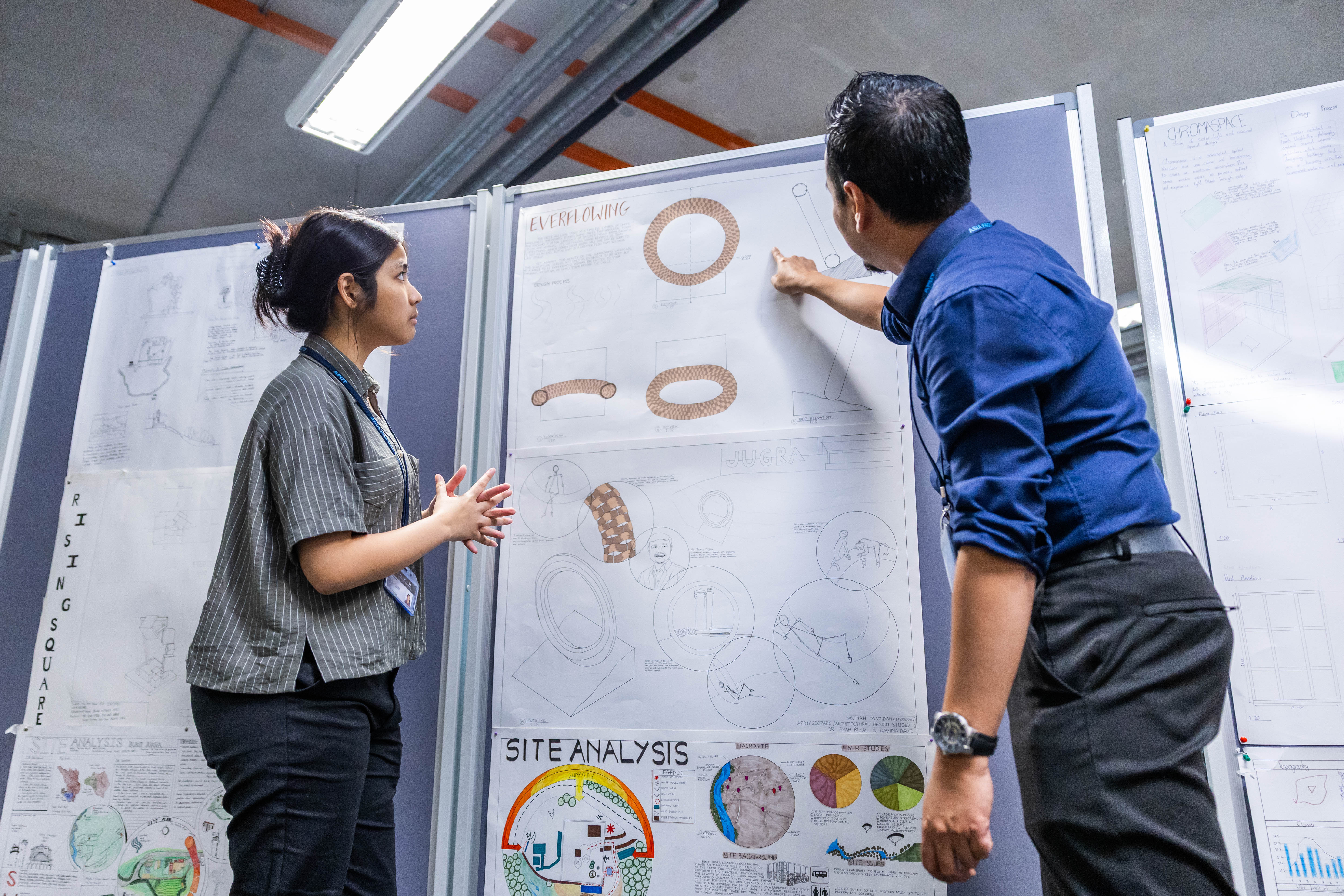



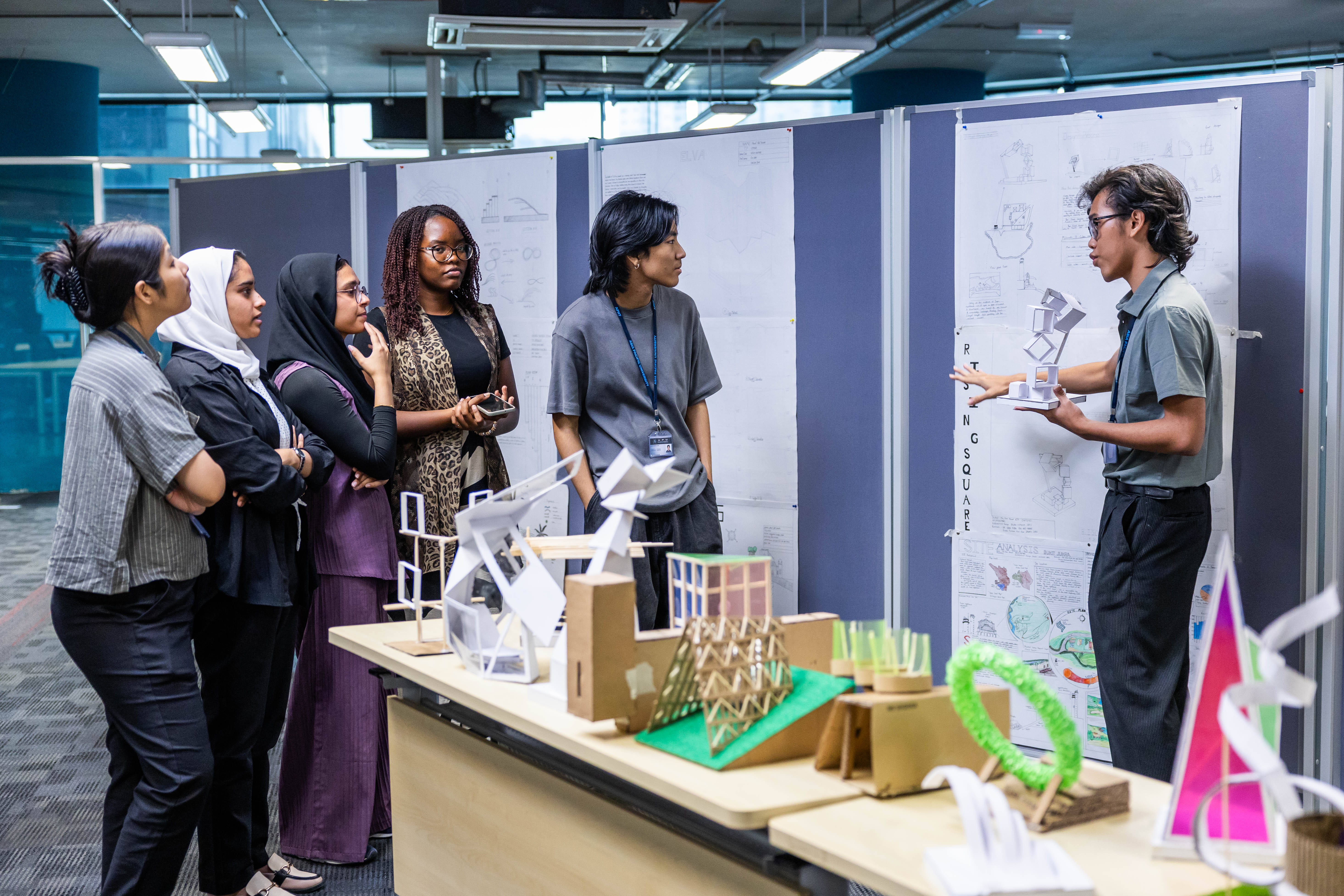




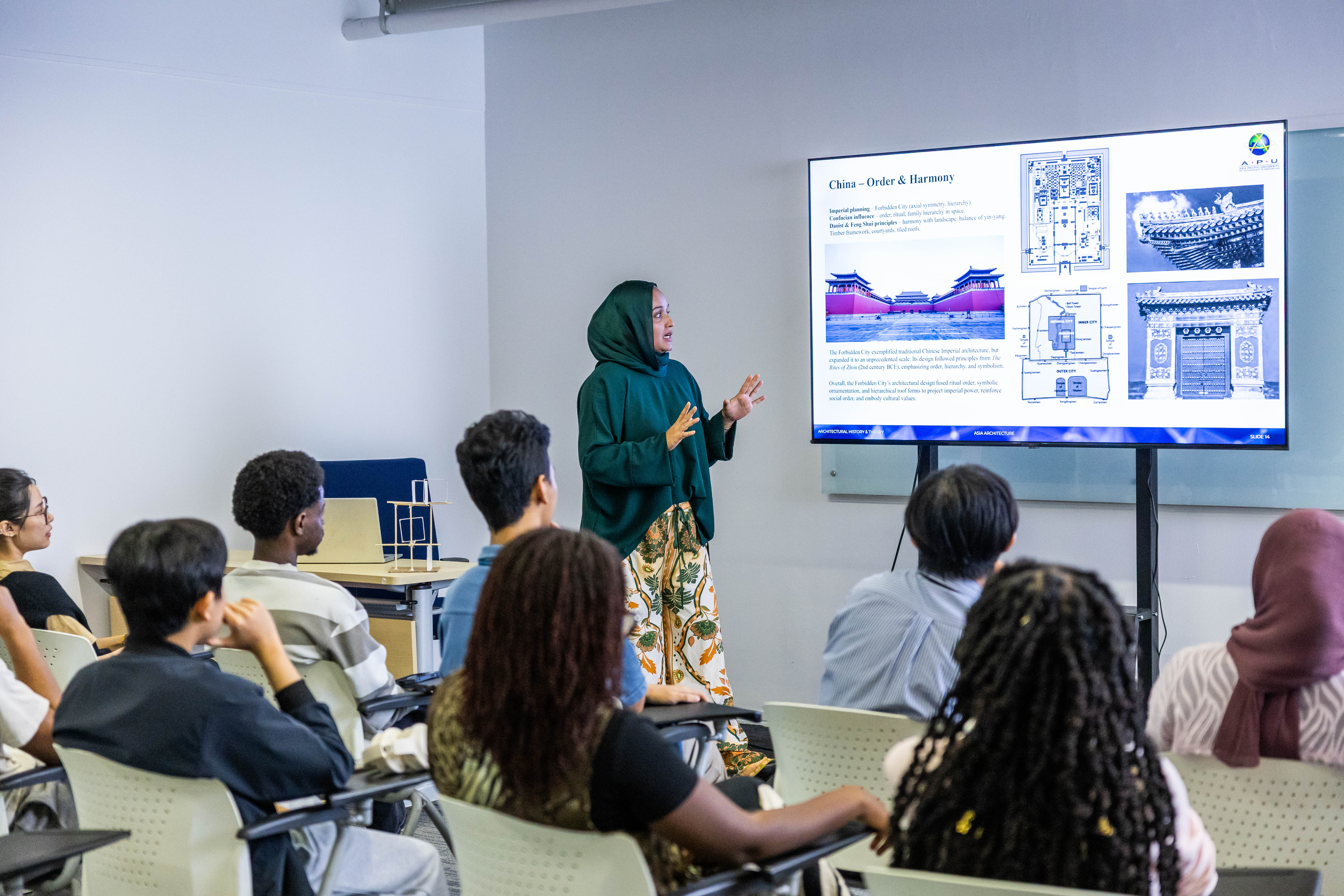


Next Generation of Graduate Architects
The School of Architecture and Built Environment is dedicated to cultivating the next generation of graduate architects who are proficient in designing not only through hand sketch but to master Building Information Modelling (BIM), deeply rooted in architectural identity, and committed to sustainable design.
Our curriculum is designed to align with government and industry blueprints especially on Hala Tuju Pendidikan Senibina Negara 2030 (National Architectural Education Roadmap 2030 - HTPSN 2030) that is as the core inspiration while supported by other blueprints such as National Fourth Industrial Revolution (4IR) Policy, CIDB’s Construction 4.0 Strategic Plan, and National Industry ESG Framework to equip students with the creative vision, technical skills, and ethical grounding necessary to address contemporary architectural challenges and opportunities. This is to make sure students cover all aspects of architectural knowledge and skills in Design, Technology and Environment, Cultural Context, Communication, & Management Practice and Law.
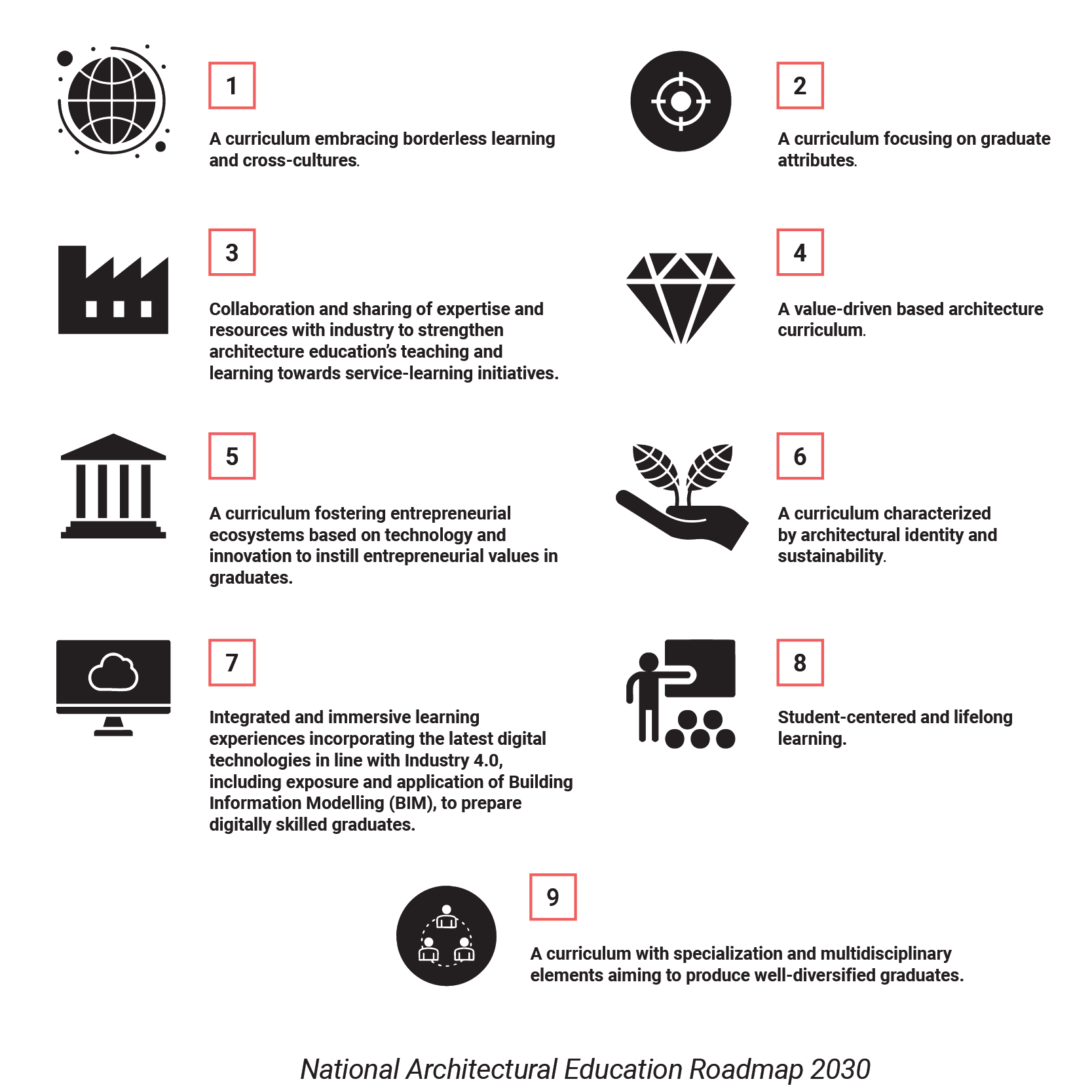
Ready, Set, Go.
Whether you are locals or traveling here, we have the options for you to pursue your dreams.
RM32,900
Year 1
RM34,000
Year 2
RM35,300
Year 3
RM102,200
Total for Malaysian
RM33,600
(USD7,815)
Year 1
RM34,800
(USD8,095)
Year 2
RM36,200
(USD8,420)
Year 3
RM104,600
(USD24,330)
Total for International
Programme code : (N/0731/6/0009)(07/29)(MQA/PA17386)
All information is correct at the time of publication, but is subject to change in the interest of continuing improvement.

Open Day
Learn More
Campus Facilities
Learn MoreEnglish Language Study
Korean Language
U-Start Programme
Want to know more ?
Let’s Connect